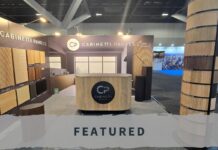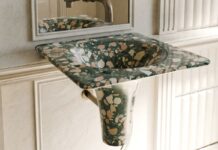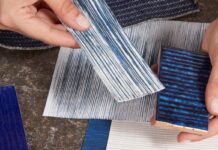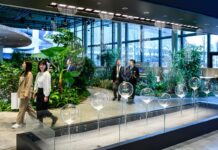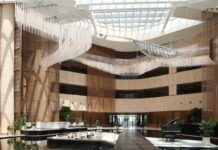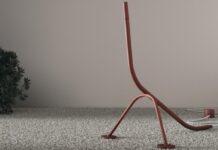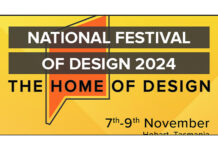Anyone who thinks that stone and concrete are the only construction materials that can be used for architecture and design and that, generally speaking, furniture has to be made from wood or conventional plastic with metal connecting elements is not thinking far enough. Interzum, the international trade fair for the furniture and interior construction industries’ supplying sections which ended recently in Cologne, examined what the future for construction materials for sustainable architecture, interior construction and interior design holds.
How to manage the available resources on the planet, process raw materials and use waste products – these are questions that are set to be an increasingly important focus of interest in coming years. And this applies to architecture and design, too, because construction projects are moving ahead at an accelerating speed because of the world’s constantly growing population and the trend for urbanisation – which means more resources are being consumed. A reorientation from consuming resources to using them is therefore urgently needed in material-intensive sectors in particular. Upcycling and biofabrication are keywords here whose importance is growing.
Not make-believe: bricks made from sand

It may be true that bricks are generally produced from natural materials such as loam or clay. But this involves extracting resources from the earth and burning them to create construction materials, consuming considerable amounts of energy in the process. According to estimates, this releases around 800 million tonnes of CO2 emissions from fossil fuels each year. American architecture professor Ginger Krieg Dosier (bioMASON) has set out to create bricks from sand and time alone. She gets some help along the way from special bacteria. When a watery solution is added, the grains of sand grow together at room temperature to form bricks – entirely without chemicals and fossil fuels.
Bacteria can also be useful in finished buildings. As concrete is exposed to extreme pressure and high tensile loads, there is a constant need for extensive refurbishment of infrastructure. Following years of research, a self-healing concrete called Basilisk (WBA) has been developed at TU Delft. After absorbing water, the bacteria excrete calcium carbonate, which forms limestone along the cracks and seals them.
Brick on brick – mortar-less construction for Lego fans

Professor Andreas Kramer from the University of the Arts (HfK) Bremen has found another way to optimise the use of materials. The special geometry of the bricks in his innovative dry-wall system (kramerDesign) means no mortar is required to lay bricks. Wall structures can simply be put together like Lego bricks. The bricks have high dimensional accuracy, ensuring a firm joint. Since the walls are built with a recycled porous granulate material, a mineral material, and no binder is used, they are made from a recyclable circular material.
New paths for interior construction

Due to the strict requirements for sustainability and fire protection, architects’ interest in integrated solutions is growing. Troldtekt acoustic panels combine both of these properties. The fire protection-classified and climate-classified panels are made from cement-bonded wood wool without chemical additives and are suitable for use in a wide range of design solutions.

Plastic is a material that we cannot do without completely – and the same goes for architects and designers. But it is usually based on petroleum, and its production involves a resource-intensive, high-energy chemical synthesis. However, research has shown that it doesn’t have to be like this: scientists have put forward processes for producing plastics from (waste) products from the food industry. One product that we consume every day can be used to produce plastic: milk. 1.7 million tonnes of colostrum are disposed of every year in Germany alone – and that’s without the overproduction. When milk turns sour, casein is produced, which is malleable when it is warm and moist. Once it has dried, the natural polymer forms a firm material that has the same properties as a thermosetting plastic.
Wood wool for furniture and interior textiles

Pine needles are a completely natural waste material that accounts for 20% to 30% of a pine tree’s total weight. With around 600 million pine trees felled each year in Europe alone, this represents an enormous quantity of raw materials. Previously, industrial use of needles was only found in pharmaceuticals. But biodegradable products such as interior textiles and carpets can be made from this material. Different processes are applied to extract the fibres inside the needle, which are then spun into a yarn. But the natural dye in the needles is also ideally suited to printing textiles. And the search for natural raw materials is far from over. Pioneers with a passion for experimenting will keep on looking for alternatives and come up with new and surprising solutions.
Visitors at the special event innovation of interior at this year’s Interzum had a chance to discover a host of other possibilities for upcycling and methods for producing biomaterials that are already available. A programme of talks on this topic accompanied the Circular Thinking exhibition, which was curated by Haute Innovation. Ideas like these give us hope for a greener future.
For more information visit
http://www.interzum.com
http://biomason.com/
https://wba.de
http://www.kramer-produkt-design.de
http://www.troldtekt.com
http://www.qmilk.eu
For more information visit imm-cologne.com
Article and images courtesy imm spotlight.


